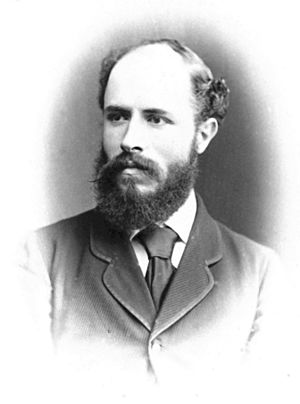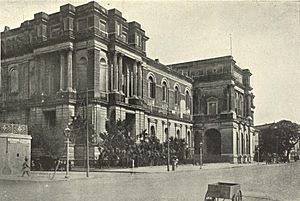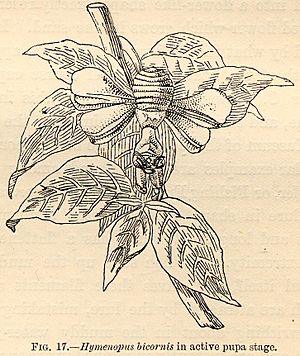James Wood-Mason facts for kids
Quick facts for kids
James Wood-Mason
|
|
|---|---|

Portrait of Professor Wood-Mason by Bourne & Shepherd (1876)
|
|
| Born | December 1846 |
| Died | 6 May 1893 (aged 47) At sea
|
| Nationality | English |
| Alma mater | Queen's College, Oxford |
| Known for | Phasmids and Mantises |
| Scientific career | |
| Fields | Entomology |
| Institutions | Indian Museum, Calcutta |
| Doctoral advisor | J.O. Westwood |
James Wood-Mason (born December 1846, died May 1893) was an English scientist. He studied animals, especially insects. He became the director of the Indian Museum in Calcutta, India.
Wood-Mason is famous for his research on stick insects (called phasmids) and praying mantises. He also collected marine animals and butterflies. The insect genus Woodmasonia and at least ten species of stick insects are named after him.
James Wood-Mason's Life and Work
James Wood-Mason was born in Gloucestershire, England. His father was a doctor. He went to Charterhouse School and then to Queen's College, Oxford for his education.
In 1869, Wood-Mason traveled to India. He began working at the Indian Museum in Calcutta. His collection of insects was still kept there many years later.
In 1872, he sailed to the Andaman Islands. He mostly studied marine animals there. However, he also collected and later described two new types of stick insects. These were Bacillus hispidulus and Bacillus westwoodii.
Wood-Mason described 24 new species of stick insects. Most of these came from South Asia. Some were also found in Australia, New Britain, Madagascar, the Malay peninsula, and Fiji.
One interesting story is about Cotylosoma dipneusticum. Wood-Mason named this stick insect in 1878. He thought it was semi-aquatic, meaning it lived partly in water. He also gave its length as "between three and four inches." This was not a very exact measurement! He thought it came from Borneo, but it was actually from Fiji.
In 1887, Wood-Mason became the Superintendent of the Indian Museum. In the same year, he became a vice-president of the Asiatic Society of Bengal.
In 1888, he sailed on a ship called the Investigator. He worked with Alfred William Alcock to study and describe new species of Crustacea (like crabs and shrimp). Alcock wrote about this journey in his book A Naturalist in Indian Seas.
Wood-Mason suffered from a serious illness for several years. On April 5, 1893, he left India to return to England because he was too sick to work. Sadly, he died at sea on May 6, 1893.
Drawing the Flower Mantis
James Wood-Mason made a beautiful drawing of a flower mantis. He gave this drawing to another famous scientist, Alfred Russel Wallace.
In his 1889 book Darwinism, Wallace wrote about the drawing. He said that this mantis, Hymenopus bicornis, looked like a pink orchid. He also mentioned other mantises that looked like flowers. One was even mistaken for a flower by a botanist!
Wallace later shared Wood-Mason's drawing with Edward Bagnall Poulton. Poulton then published it in his 1890 book, The Colours of Animals.
Honors and Recognition
James Wood-Mason received several honors for his work. He was a Fellow of the Royal Entomological Society. In 1888, he also became a Fellow of the University of Calcutta.
More than ten marine animals are named woodmasoni in his honor. Many of these were described by Alfred William Alcock, who sailed with Wood-Mason on the Investigator. Some examples include Heterocarpus woodmasoni and Thalamita woodmasoni.
Two species of snakes are also named after him: Oligodon woodmasoni and Uropeltis woodmasoni.



